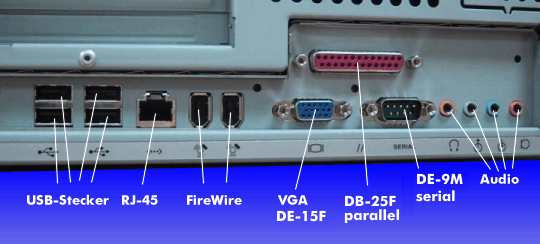interface (I/F)
An interface, interface (I/F), is a defined transition between data transmission devices, hardware components, logical software units or between human and computer. Interfaces meet a wide variety of requirements and applications: electrical and physical, transmission modes, protocols, and modes of operation.
Transmission interfaces are suitable for point-to-point connections or multipoint connections and are designed for private or public networks.
The interface as a network and subscriber transition
As a network and subscriber transition, the interface defines the physical characteristics of the interface lines as well as the signals exchanged on the interfaces and their functionality.
The interface delimits technical functions and/or administrative responsibilities for devices and networks. Every network architecture, whether local area network( LAN), metropolitan area network ( MAN), wide area network (WAN) or access network( AN), and every network concept, whether packet-, cell- or line-oriented, whether analog or digital, whether wireline or radio-based, has its own network and subscriber interfaces, such as the ISDN interfaces, the ATM transmission interfaces, the analog network interfaces or the air interfaces.
Standardization, drawn up by international and national bodies, covers the electrical signals on the interface lines, the mode of operation, i.e. the timing of the signals, and the meaning. In the USA, the best-known standards originate from the Electronics Industry Association( EIA), and include the Recommended Standards( RS); in Europe, they are the standards of the International Telecommunication Union( ITU). The network-internal interfaces of the telecommunications networks fall under the sovereignty of the network operators and are normally not accessible to the user.
Interfaces in computer and PC technology
In computer and PC technology, interfaces are internal bus interfaces between the central processing unit( CPU) and the boards, function and memory units or interfaces for the direct connection of external peripheral devices. These are in turn divided into analog and digital interfaces.
The bus interfaces include the Small Computer System Interface( SCSI), Serial Attached SCSI( SAS), the PCI bus, Direct Memory Access( DMA) and Ultra-DMA as well as Advanced Technology Attachment( ATA). The various interfaces meet the increased demand for high transfer rates and simple connector technology. The specification of an interface contains information about transfer rates, transfer methods, the number of interface lines, the plug, socket or connector strip and their assignment.
As far as external peripheral interfaces are concerned, there is the classic analogVGA interface as well as various analog video interfaces and the modern digital interfaces such as IEEE 1394, Firewire and the USB interface with data rates of up to 5 Gbit/s, as well as various display interfaces such as Digital Flat Panel( DFP), Digital Visual Interface( DVI), DisplayPort, the HDMI interface and the MHL interface as well as some others with data rates of up to 25 Gbit/s.
The digital interfaces work with special transmission methods such as Transition Minimized Differential Signaling( TMDS), Low Voltage Differential Signaling( LVDS) or V-by-One HS.
Software interfaces
In addition to the hardware interfaces, there are also the software interfaces, with which the transition from one program to another is realized.

